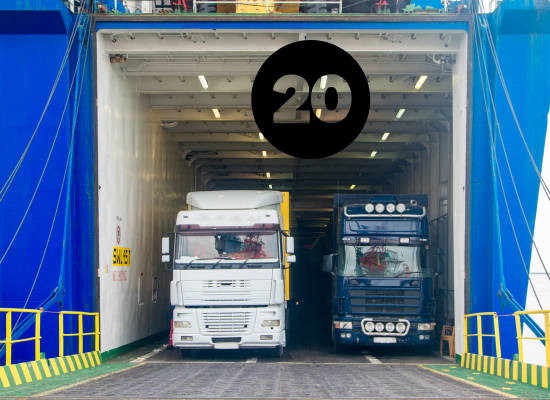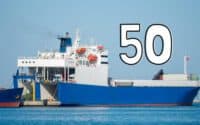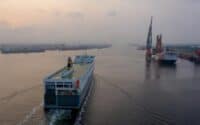20 Key Considerations in a RoRo Conversion

In the dynamic world of maritime shipping, adapting vessels to meet changing market needs is a strategic necessity. Converting a traditional cargo or ferry ship to include roll-on/roll-off (RoRo) capabilities is a complex yet rewarding endeavor that can significantly enhance operational flexibility and economic viability. This article outlines twenty key considerations for shipowners and operators contemplating such a conversion, providing a detailed roadmap from initial assessment to post-conversion optimization.
* Please send feedback/suggestions to editor @ shipuniverse.com
1. Feasibility Study and Initial Assessments
Before any conversion project begins, a comprehensive feasibility study must be conducted. This involves assessing the existing structure and design of the ship to determine if it can physically and economically support the necessary modifications for RoRo capabilities. This study should include a detailed analysis of the vessel’s current condition, load-bearing capacity, stability, and the potential return on investment. Consulting with naval architects and marine engineers during this phase is essential.
2. Design and Engineering Plans
Converting a ship to a RoRo involves significant design changes. This requires detailed engineering plans that include the addition of large access doors, ramps, and possibly internal decks. These modifications need to be designed in a way that maintains the ship’s structural integrity and stability. The plans should outline all structural reinforcements needed to support the new operational demands, ensuring compliance with maritime safety regulations.
3. Regulatory Compliance and Certification
RoRo conversions must meet specific regulatory standards set by maritime authorities and classification societies. Compliance with these standards is mandatory for the operation of RoRo vessels. Obtaining the necessary certifications involves rigorous inspections and possible modifications to meet safety, environmental, and operational regulations. Early engagement with these regulatory bodies can help streamline the process and avoid costly redesigns or retrofitting.
4. Budget and Cost Analysis
The financial aspect of converting a ship to RoRo capabilities cannot be overlooked. A detailed budget should be prepared, taking into account not only the initial conversion costs but also long-term operational expenses. This includes the costs of design, construction, labor, materials, and any downtime required during the conversion. Comparing these costs against the expected operational savings and increased revenue from RoRo operations is crucial for determining the economic viability of the project.
5. Structural Modifications
Converting a ship to a RoRo vessel often requires extensive structural modifications. These might include cutting through the ship’s hull to install large doors and creating reinforced vehicle decks. Each modification must be carefully planned to ensure it does not compromise the vessel’s overall structural integrity. Special attention must be given to watertight integrity and the potential for corrosion, which can be heightened by the increased exposure to vehicles and their cargoes.
6. Stability and Ballast Adjustments
The addition of ramps and vehicles can significantly alter a ship’s weight distribution and center of gravity. To maintain stability, modifications may be needed in the ship’s ballast system. This might involve recalculating the ship’s stability with new load conditions and possibly redesigning or adding ballast tanks. These adjustments are crucial for ensuring that the vessel remains safe and compliant with international stability standards.
7. Ramp Design and Installation
The design and installation of ramps are crucial for the functionality of a RoRo ship. Ramps must be robust enough to handle the weight and traffic of vehicles while also being easy to operate. Considerations include the choice of materials, the structural support, and the mechanics of how ramps will deploy and retract. Additionally, the angles of ramps must be manageable for vehicles to ascend and descend safely under various load and weather conditions.
8. Internal Traffic Management
To efficiently operate as a RoRo vessel, internal traffic flow must be meticulously planned. This includes the layout and marking of vehicle lanes, the location of parking spots, and the logistics of loading and unloading to minimize congestion and turnaround time. Safety measures must also be in place to manage the movement of vehicles and personnel during operations. This often requires installing new signage, safety barriers, and emergency response equipment.
9. Operational Efficiency
Efficiency in operations is key for RoRo conversions, affecting turnaround times and overall vessel performance. It is crucial to integrate advanced loading and unloading systems that can handle peak capacities and adapt to different vehicle sizes and weights. This may include automated systems or specialized handling equipment designed to speed up operations while minimizing labor costs and error rates.
10. Safety Systems and Emergency Procedures
Safety is paramount in RoRo operations due to the increased risk associated with vehicle movements on board. This includes installing fire suppression systems in vehicle areas, adequate ventilation to handle exhaust gases, and robust emergency response plans tailored to potential scenarios such as fires or vehicle mishaps. Training crew members in these new safety protocols and conducting regular drills will help ensure readiness and compliance with international safety standards.
11. Crew Training and Operational Changes
Converting to a RoRo operation requires that the crew be well-trained in new procedures and equipment. This training should cover the operation of new machinery, emergency response actions, and safety protocols specific to RoRo vessels. Additionally, operational roles may need to be redefined to handle the specific needs of loading, securing, and unloading vehicles, which differs significantly from traditional cargo handling.
12. Maintenance and Upkeep
The addition of complex mechanisms such as ramps and hydraulic systems introduces new maintenance challenges. A regular maintenance schedule must be established to ensure that these components remain in good working order and do not pose a safety risk. This includes routine inspections, lubrication, and repairs, all tailored to the harsh maritime environment where corrosion and wear are significant concerns.
13. Load Management and Distribution
Proper load management and distribution are essential to maintain the ship’s balance and stability. The conversion design must include plans for evenly distributing vehicles and cargo across the available deck space. This may involve sophisticated load planning software and systems to help in calculating weight distribution and optimizing space usage.
14. Integration of New Technologies
Incorporating new technologies can significantly enhance operational efficiency and safety. This includes installing automated systems for managing vehicle entry and exit, electronic cargo tracking systems, and advanced navigation aids. Consideration should also be given to cybersecurity measures to protect these technologies from potential threats.
15. Insurance and Liability Considerations
Converting a vessel to RoRo capabilities can alter insurance requirements and liability considerations. It’s important to consult with insurance providers to ensure that coverage reflects the new operational risks and values. Adjustments might be needed in the insurance policy to cover potential damages related to vehicle handling and storage.
16. Marketing and Business Strategy
Finally, revising the marketing and business strategy to reflect the new RoRo capabilities is crucial. This includes identifying new markets and customer segments that can be served with the converted vessel. Effective communication of the enhanced capabilities to potential customers, logistics companies, and port operators will help in maximizing the return on investment.
17. Long-term Strategic Alignment
Evaluate how the conversion aligns with the long-term strategic goals of the shipping company. This includes considering future market trends, potential changes in trade routes, and evolving industry regulations. The conversion should support the company’s broader objectives for growth, operational efficiency, and sustainability.
18. Adaptation to Market Demand
Understand the fluctuating demand in markets that utilize RoRo shipping. Assess whether the conversion will allow the vessel to flexibly respond to changes in market needs, such as variations in the type and volume of vehicles and goods transported. This flexibility can be crucial in maximizing vessel utilization and profitability.
19. Crew Adaptability and Change Management
Managing the change process within the organization, particularly for the crew who will operate the converted vessel, is vital. This involves not only training but also supporting the crew through the transition to new operating procedures and technologies. Effective change management can help minimize resistance and maximize acceptance and competency in new RoRo operations.
20. Post-Conversion Evaluation and Optimization
After the conversion, conducting a thorough evaluation of the vessel’s performance in real operational conditions is essential. This should involve monitoring the efficiency of loading and unloading operations, stability performance, and overall operational safety. Feedback from these evaluations can be used to optimize procedures and if necessary, make further modifications to improve functionality and safety.
Embarking on the conversion of a maritime vessel to RoRo capabilities is a multifaceted process that requires meticulous planning, substantial investment, and strategic foresight. By thoroughly addressing the twenty key considerations discussed, stakeholders can ensure that the conversion not only meets technical and regulatory standards but also aligns with broader business objectives. Such transformations, when successfully executed, can position maritime operations to capitalize on new opportunities and adapt more readily to the evolving demands of global trade.

Do you have any feedback or additional insights? Please reach out to editor @ shipuniverse.com



